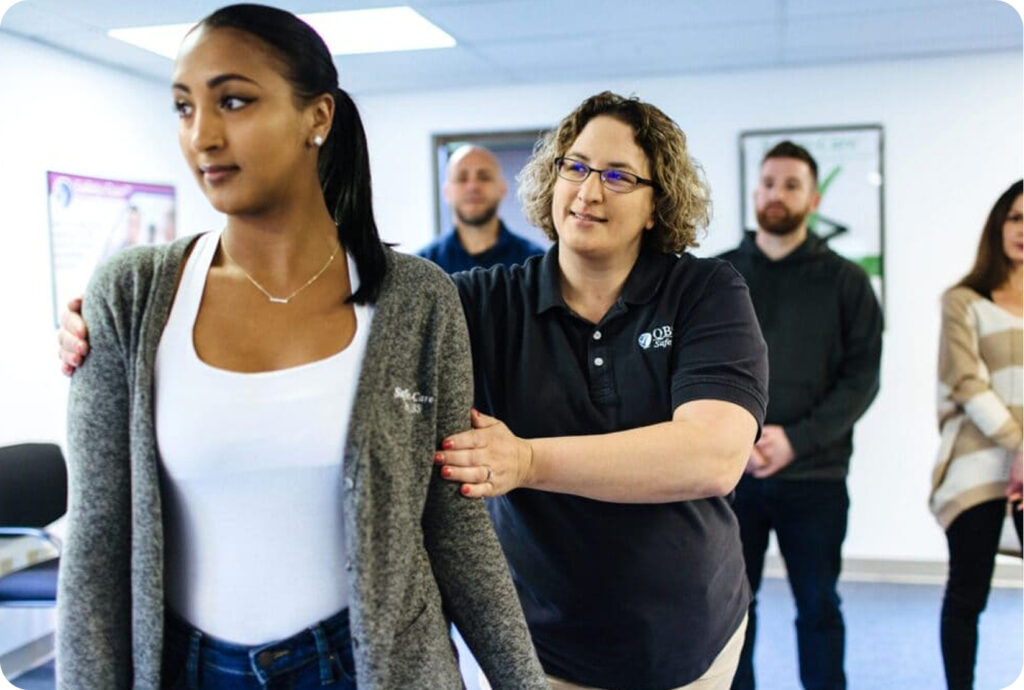ASM is a full day of trainer training. If the entire ASM course is taught to staff, the specialist version takes 5–6 hours. The module is intended to provide a toolbox to address a wide range of potential issues. Some organizations may teach all of the procedures in ASM, while others will choose only the ones that are most applicable and appropriate.

Advanced Skills Module
The Advanced Skills Module (ASM) builds on the Safety-Care core curriculum to provide a broad range of additional skills and strategies.
Curriculum Content
Introduction
Discussion of planning, teamwork, and implementation when working with individuals with the potential to exhibit very dangerous behavior.
Advanced Physical Safety
Expands on the grab release procedures taught in the Safety-Care core curriculum by adding a Rear Hair Pull Release, Rear Choke Release, and Head Lock Release. Additionally, there is a Triad Tactics procedure to allow a team of three staff to work together to safely de-escalate an agitated individual who demonstrates a high potential for dangerous behavior.
Peer Aggression
Peer aggression is a significant problem in many settings. This chapter includes strategies for preventing and managing peer aggression, including breaking up fights and other conflicts. Training includes recommendation about how to implement a plan to minimize future incidents.
Vehicle Safety
A behavioral crisis in a vehicle can be extremely dangerous, especially if it’s moving. This section reviews prevention strategies for challenging behavior in vehicles and two physical competencies specifically for use in vehicles: Hip Sit and 1-Person Seated Stability Hold.
Advanced Physical Management
This chapter provides additional physical management procedures. It includes the Lift to Standing Transition (to move a person from a seated hold to a standing hold), the Standing to Seated Transition (to move a person from a standing hold to a seated hold), and the Object Control Stability Hold (an emergency procedure to place a person who is using a dangerous object in a highly dangerous manner into a 2-person hold).
Floor Holds
A floor hold is a more restrictive procedure that should be used only when less restrictive interventions are not sufficient to safely manage a severe behavioral crisis. This section includes the Supine Stability Hold, the Standing to Supine Transition, and the Seated to Supine Transition.
Blocking Pad Procedures (Optional)
By special arrangement, an optional blocking pad section can be added to this training and is only trained if requested and if blocking pad equipment is provided by the participant. Request equipment info if interested in learning the blocking pad procedure.
Equipment for Blocking Pad Procedures
We cannot provide the pads at a training, and if no pads are available, we will not be able to teach that section. Three pads are needed to teach all of the relevant procedures. Blocking pads are protective equipment designed for practice in sports (football, martial arts, etc). Pads should be large enough to provide significant protection—approximately 2–3 feet / 60–90 cm tall by 1.5 feet / 45 cm wide. Extremely large or extremely small pads are not recommended. Pads should not look threatening or have graphics that depict violence (fists, hitting, tackling, weapons, aggressive slogans, etc.).
The equipment must be constructed so that it is sturdy but padded enough to protect both aggressor and staff from injury. It must also have straps that allow it to be easily grasped and maneuvered by the staff person, and not be heavy or rigid enough to make an effective weapon. The organization is responsible to choose, purchase, and maintain appropriate equipment.
For your convenience we can refer you to some links for blocking pads. Please keep in mind that we do not specifically endorse these products in terms of longevity or overall quality. We recommend you also do your own research.